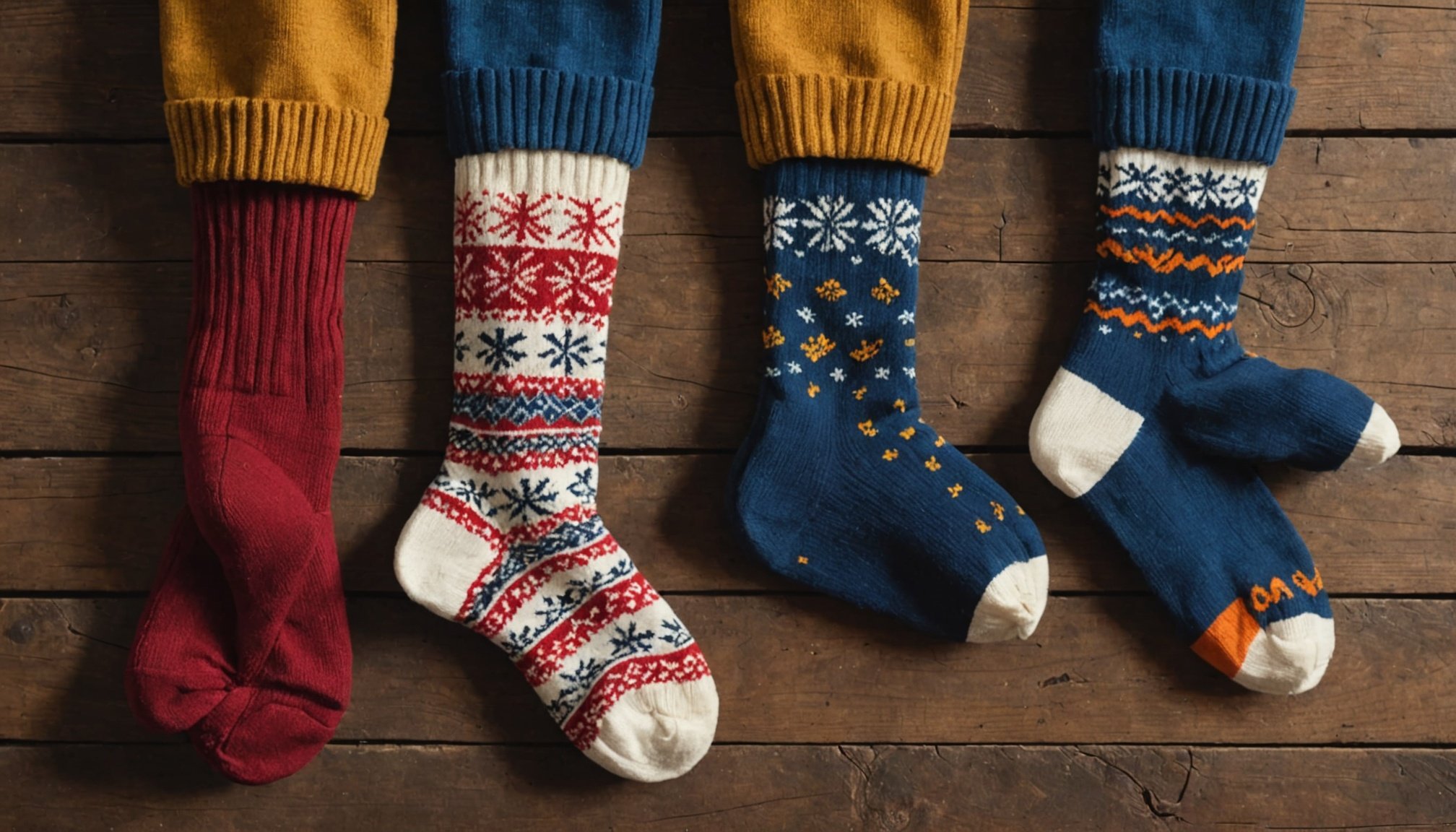Understanding Winter Sock Materials
When considering winter sock materials, the properties of each option significantly impact both comfort and warmth. A popular choice, the sock wool blend, is noted for its excellent insulation and natural moisture-wicking attributes, helping to maintain dry feet even in damp conditions. It combines the thermal benefits of wool with the durability of synthetic materials.
On the other hand, synthetic fibers, while not as warm as wool, offer durability and budget-friendly prices. These are often enhanced with moisture-wicking fabrics to counteract the main drawback of synthetics: poor breathability. The ability to wick moisture away from the skin is crucial in winter socks, as it prevents the chilling effect of sweat evaporating.
Also to discover : Pioneering UK Designers Revolutionizing Gender-Neutral Fashion Trends
Natural fibers like merino wool serve as a premium choice due to their soft texture and superior warmth. They also naturally manage moisture, reducing odour and keeping feet dry. In contrast, synthetics like polyester, often engineered to enhance moisture control, are ideal for high-intensity activities where perspiration is a factor.
Balancing the properties of both natural and synthetic materials ensures an optimal mix of warmth, comfort, and practicality in various winter scenarios.
Also to discover : Conquer Chilly UK Shores: Choosing the Ideal Swimwear for Cool Coastal Outings;235Top Tips for Choosing Your Ideal Race Day Hat in the UK
Insulation and Thickness Considerations
When selecting winter socks, sock insulation types play a crucial role in achieving optimal warmth. Insulated socks, often labelled as thermal socks, provide an extra layer of heat retention essential for cold conditions. These socks typically incorporate various materials that trap heat, maintaining foot temperature even in frigid environments.
The thickness levels of winter socks significantly influence both comfort and warmth. Thicker socks generally offer enhanced insulation and are ideal for extremely cold temperatures or outdoor activities where staying warm is vital. However, very thick socks may compromise comfort by reducing space within footwear, potentially leading to restricted blood flow.
For everyday wear, moderate thickness strikes the right balance between comfort and thermal efficiency. If engaging in activities like hiking or skiing, opt for socks that combine insulation with medium thickness for warmth without forfeiting mobility.
Considering both activity and environmental conditions will help find the ideal sock thickness. Whether you’re traversing snowy trails or just braving the winter city commute, choosing the correct combination of sock insulation and thickness ensures your feet remain warm and comfortable throughout the cold season.
Key Features to Look For
When evaluating winter sock features, consider those that blend comfort and function for optimal performance. Cushioning is fundamental, providing extra padding to reduce pressure on the feet. This aspect is crucial during long periods of wear or intense activities, ensuring feet remain comfortable without strain.
Arch support also plays a significant role in enhancing fit and maintaining foot alignment, which can prevent fatigue on extended winter outings. Socks with built-in arch support create a snug fit, distributing pressure evenly across the foot.
Look for additional details like seamless toes, which minimise irritation, making them ideal for sensitive skin. Reinforced heels further enhance durability by withstanding regular wear and tear, essential for those who are active outdoors.
These features collectively contribute to the sock’s functionality, keeping feet warm and comfortable regardless of winter challenges. Investing in socks with these characteristics ensures that you’re well-equipped to face winter’s demands, whether lounging at home or exploring icy trails.
Comparisons of Popular Winter Sock Types
Understanding the different types of winter socks helps in making an informed choice for various activities or conditions. Each type offers distinct benefits tailored to specific needs.
Hiking Socks
Hiking socks are designed for outdoor endeavours requiring robust support and protection. They typically feature increased cushioning to absorb shocks, providing comfort on rugged trails. Moisture-wicking fabrics keep feet dry, essential to prevent blisters during long hikes.
Thermal Socks
Thermal socks are specialists in heat retention. They often utilise advanced sock insulation techniques, making them perfect for extremely cold environments. Their bulkier design, combined with high insulation, ensures feet stay warm but may limit flexibility.
Everyday Winter Socks
For daily use, everyday winter socks balance comfort with functionality. They usually incorporate moderate cushioning and insulation sufficient for general winter wear without excess bulk, making them ideal for urban settings.
When selecting the right type, consider the activities you’ll engage in. While hiking socks prioritize support, thermal options excel in warmth. Everyday socks strike a versatile balance, suitable for a range of winter conditions. Choosing based on intended use ensures the comfort and protection of your feet.
User Reviews and Brand Recommendations
When seeking the best winter sock brands, customer feedback is invaluable. Winter sock reviews reveal insights into the durability, warmth, and comfort of various brands. Consumers often praise top brands for their exceptional moisture-wicking fabrics, which play a pivotal role in maintaining warm and dry feet.
Popular brands frequently cited for quality include those that prioritize sock wool blends, enhancing insulation without sacrificing flexibility. Additionally, feedback suggests high satisfaction with brands offering reinforced cushioning and arch support, adding substantial comfort during prolonged wear.
From these reviews, it’s evident that consumers also value socks incorporating natural fibres, as they tend to offer superior warmth and moisture management. Brands that balance the properties of natural and synthetic materials often receive the highest recommendations, as they effectively cater to diverse winter activities.
For those interested in exploring different options, it’s beneficial to consider brands with positive reputations for producing well-constructed winter socks incorporating user-friendly features. Such brands consistently deliver products that meet and exceed expectations in terms of comfort and warmth across various conditions.
Tips for Maintaining Warmth and Comfort
To maximise the warmth and comfort of winter socks, strategic layering can be incredibly effective. Wearing multiple layers traps air between the fibres, enhancing insulation. However, be cautious—too many layers may restrict circulation, causing cold feet instead of warmth.
Following proper sock care tips is essential for longevity and continued functionality. Hand washing or using a gentle cycle in lukewarm water helps maintain the integrity of moisture-wicking fabrics. Avoid fabric softeners, which can damage these specialised fibres.
Maintaining warmth involves more than just wearing thick socks. Using sock wool blends ensures even temperature regulation while keeping moisture away from the skin. Natural and synthetic fibre combinations enhance durability and thermal efficiency, enabling use in various situations without compromising comfort.
For added comfort, ensure your socks fit properly. Loose socks can cause friction, leading to blisters, while overly tight ones can hinder circulation. By purchasing the right size and considering the activities you’ll engage in, these precautions will ensure your winter socks remain effective in keeping you cosy all season.






